
The Dai people are several Tai-speaking ethnic groups living in the Xishuangbanna Dai Autonomous Prefecture and the Dehong Dai and Jingpo Autonomous Prefecture of China's Yunnan Province. The Dai people form one of the 56 ethnic groups officially recognized by the People's Republic of China. By extension, the term can apply to groups in Laos, Vietnam, Thailand and Myanmar when Dai is used to mean specifically Tai Yai, Lue, Chinese Shan, Tai Dam, Tai Khao or even Tai in general. For other names, see the table below.

The art of paper cutting in China may date back to the 2nd century CE, when paper was invented by Cai Lun, a court official of the Eastern Han dynasty.

Dance in Cambodia consists of three main categories: classical dance of the royal court, folk dance which portrays cultural traditions, and social dances performed in social gatherings.
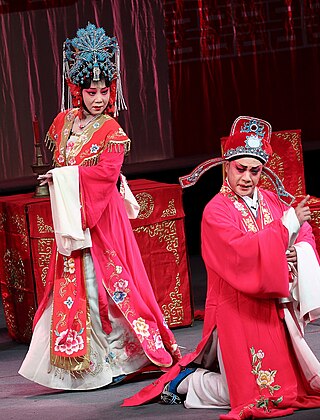
Yu opera, or Yuju opera, sometimes known as Henan bangzi, is one of China's famous national opera forms, alongside Peking opera, Yue opera, Huangmei opera and Pingju. Henan province is the origin of Yu opera. Henan's one-character abbreviation is "豫" (yù), and thus the opera style was officially named "豫剧" (Yùjù) after the founding of the People's Republic of China. The area where Yu opera is most commonly performed is in the region surrounding the Yellow River and Huai River. According to statistical figures, Yu opera was the leading opera genre in terms of the number of performers and troupes. While Yu opera is often called "Henan opera" in English, within Henan it is considered to be just one of the province's three most important forms of opera, the other two being Quju (曲剧) and Yuediao (越调).
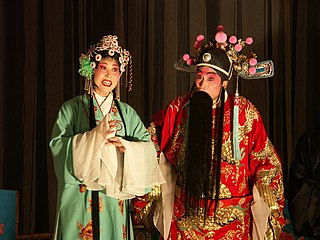
Sichuan opera is a type of Chinese opera originating in China's Sichuan province around 1700. Today's Sichuan opera is a relatively recent synthesis of 5 historic melodic styles. Regionally Chengdu remains to be the main home of Sichuan opera, while other influential locales include Chongqing, Guizhou, Yunnan, Hubei and Taiwan. Sichuan Opera was listed in the first batch of 518 national intangible cultural heritage list announced on May 20, 2006.

Dance in Indonesia reflects the country's diversity of ethnicities and cultures. There are more than 1,300 ethnic groups in Indonesia. Austronesian roots and Melanesian tribal forms are visible, and influences ranging from neighboring Asian and even western styles through colonization. Each ethnic group has its own dances: there are more than 3,000 original dance forms in Indonesia. The old traditions of dance and drama are being preserved in the numerous dance schools which flourish not only in the courts but also in the modern, government-run or supervised art academies.
Yanjin County is a county under the administration of the prefecture-level city of Xinxiang, in the north of Henan province, China.

Qin'an County is a county in the east of Gansu province, China. It is under the administration of the prefecture-level city of Tianshui. Its postal code is 741600, and in 1999 its population was 567,553 people. As of 2018, the population is 618,000 people. It is one of the poorest counties of Gansu, being appointed as one of 23 counties part of a provincial poverty alleviation project.
Luolong District is a district of the city of Luoyang, Henan province, China.

Sundanese dances is a dance tradition that is a part of ritual, artistic expression as well as entertainment and social conduct among the Sundanese people of West Java and Banten, Indonesia. Sundanese dance is usually cheerful, dynamic and expressive, with flowing movements in-sync with the beat of kendang accompanied with Gamelan degung music ensemble.
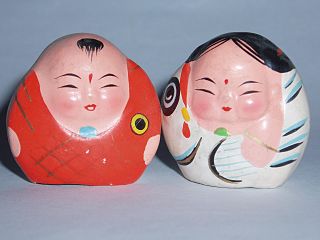
Huishan clay figurine is a traditional Chinese folk art in Wuxi, Jiangsu Province, China, with a history of more than 400 years. The production of Wuxi Huishan clay figurines began at the end of the Ming dynasty and developed in the Qing dynasty with specialized Huishan clay craftsmanship workshops. On May 20, 2006, Huishan clay figurine was added to the first batch of National intangible cultural heritage lists with the approval of the State Council of the People's Republic of China.
Guanniu, also known as Chinese bullfighting or Chinese-style bullfighting, is a form of bull-wrestling contest held in Jiaxing, Zhejiang Province, China. It is also known as Hui bullfighting (回族斗牛). because it originated among the Hui people. The word guan means throwing, dropping, or tossing, and niu refers to cattle, so guanniu translates literally as 'wrestling with a bull'.
The Miao Flower Mountain Festival, also known as the Treading on Flower Festival, is a traditional occasion for the Miao, a Chinese ethnic group. It represents a chance for the youth to express love and a chance for middle-aged and older people to bless each other.
Wu Bing'an was a Chinese ethnologist and an expert on folklore and popular culture. He was a professor of Liaoning University and served as President of the Chinese Folklore Society.
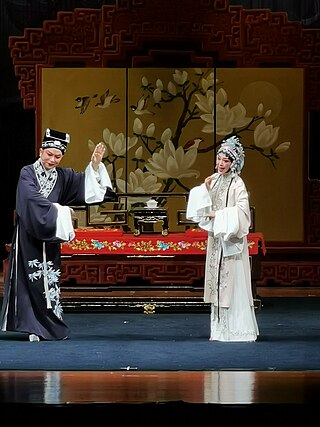
Xiju, also known as Wuxi opera, is a genre of opera which originated in the southern region of the Yangtze River Delta in China. It evolved from "Tanhuang" (滩簧), a folk opera art in the region of Wuxi and Changzhou of Jiangsu province. As one of the main local operas in Jiangsu Province, Wuxi opera has been reputed as "a piece of plum flower in Taihu Lake", a title given to the three major operas in East China, alongside Yue opera and Huangmei opera.
Holboo is a Mongolian vocal art form that originated around the 12th century A.D. At first, it spread to the Horqin and Harqin areas, and then extended to other Mongolian settlements in Inner Mongolia Autonomous Region and its surrounding provinces. The singing forms of Holboo include singing, duet singing, duet singing and multi-person chorus. Holboo is sung in an impromptu manner, and the lyrics are similar to folk songs. On June 7, 2008, Holboo was listed in the second batch of the List of national intangible cultural heritage of China.
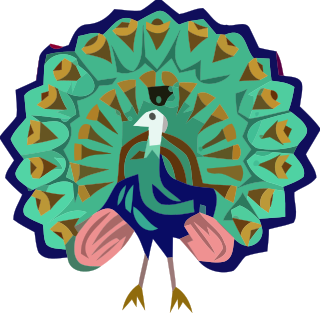
The Peacock Princess or Chao Sisouthone and Nang Manola is a Tai legend. This story features in the folklore of Myanmar, Cambodia, Thailand, Laos, Sri Lanka, northern Malaysia, Indonesia, Vietnam and China.
Luoshan Dragon is a traditional dragon dance of the Lishui District and Fengzhen Luoshan Village, Nanjing,China.Luoshan Dragon is an intangible heritage, those is local one of the importance folk culture activity, has been 400 years history.
The Third Month Fair is one of the most important festivals celebrated by the Bai people of southwest China. It includes a street bazaar, performances, sports, and games, and takes place annually in Dali City, Yunnan. The fair lasts several days, starting on the 15th day of the third month of the Chinese calendar. In 2024, it begins on April 23.


















